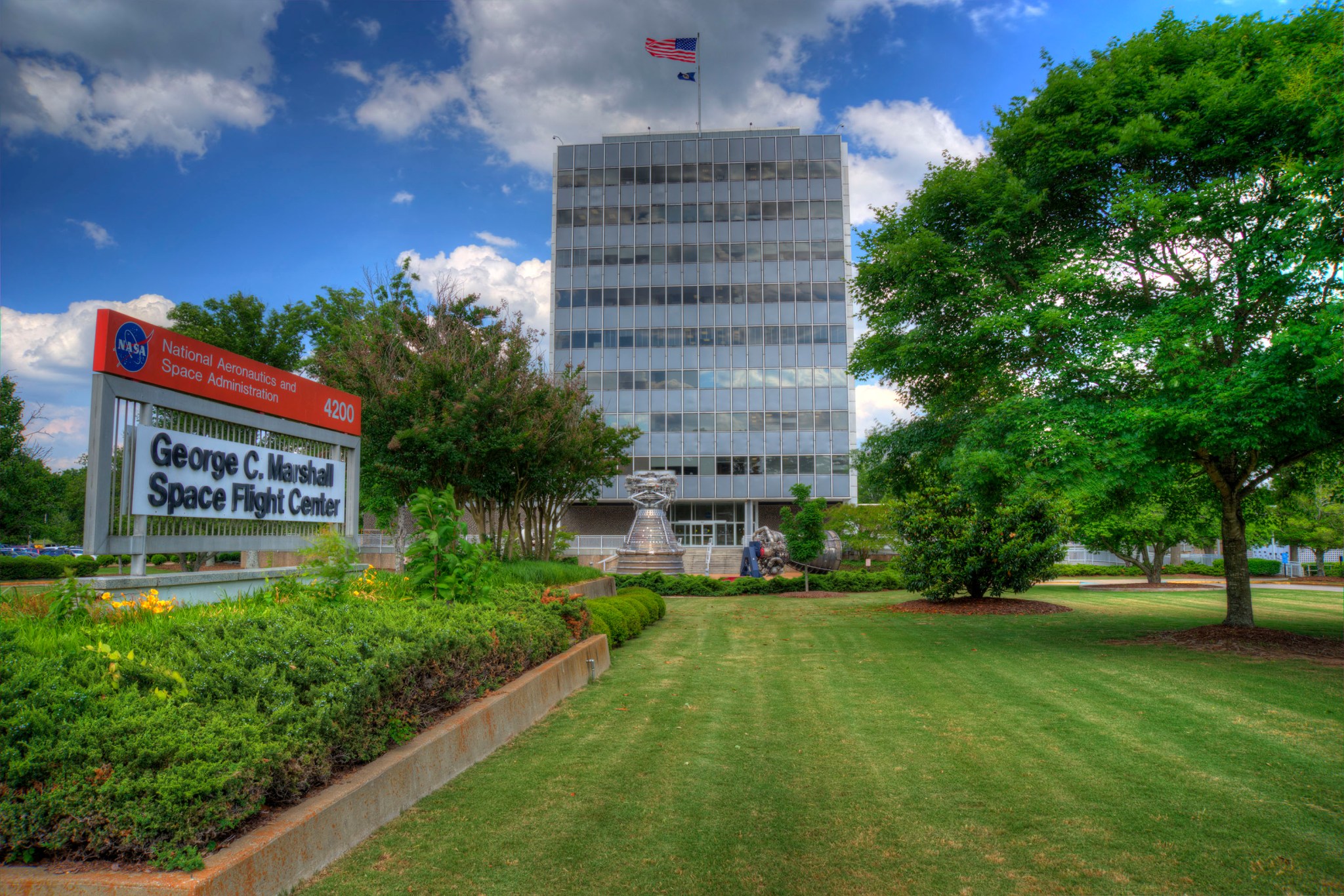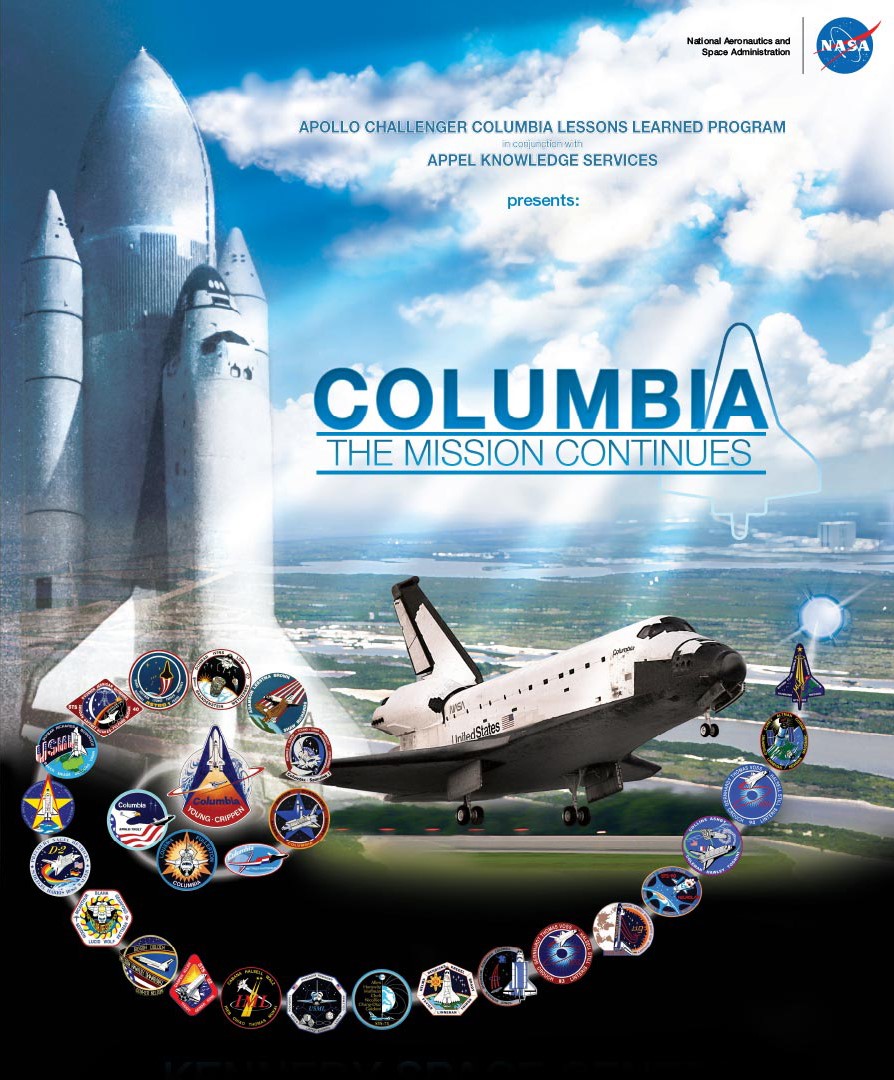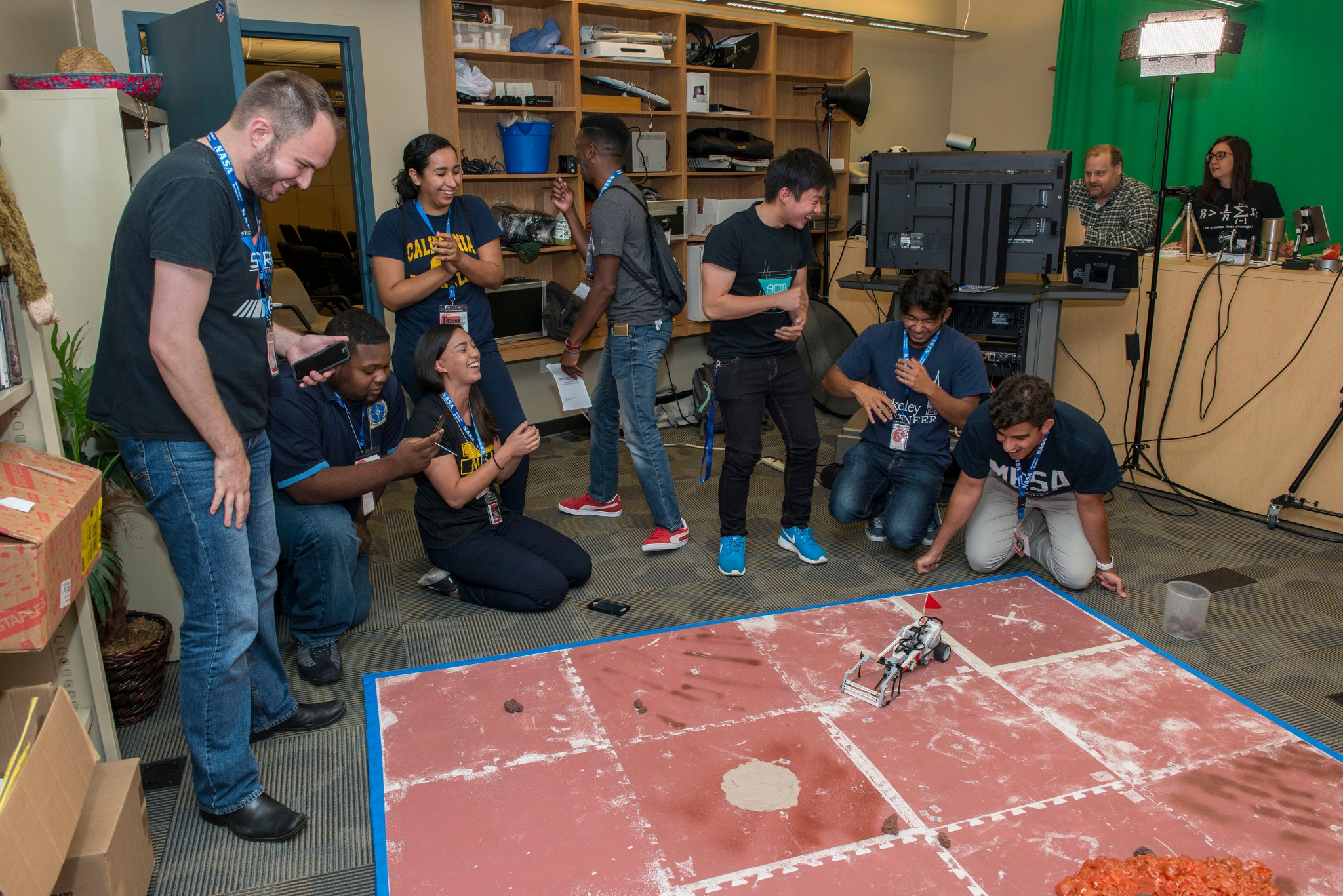In This Week’s Star
- NASA Early Career Initiative Program Selects 7 Proposals, including 2 from Marshall
- Marshall Celebrates 20 Years of Science with Chandra
- Save the Date: Space Shuttle Columbia National Tour, Decision Management Course Coming to Marshall
- Progress to the Pad: The Hardware for NASA’s Artemis I Mission Comes Together
- RSIC Building to Close; Online Registration Deadline Nearing
- Marshall to Host Community College Students Sept. 23-27, Team Members Invited to Attend Networking, Competitive Events
- Learn How Apollo F-1 Engines Were Recovered from Atlantic Ocean
- Astrobotic Mission Director to Deliver Tech Talk on Sept. 12
- Former Johnson Director Ellen Ochoa Delivers Final 2019 Shared Experiences Talk at Marshall
- This Week in NASA History: STS-106 Launches to International Space Station – Sept. 8, 2000
NASA Early Career Initiative Program Selects 7 Proposals, including 2 from Marshall
By Rick Smith
NASA’s Early Career Initiative program, a technology maturation effort led by NASA early career employees and their external partners, has announced its project selections for fiscal year 2020, launching a new season of innovation that could bolster exploration of the Moon and Mars — and aid the careers of those who will lead us there.
Of the 15 submitted proposals for fiscal year 2020, NASA’s Space Technology Mission Directorate selected a total of seven awardees. For the first time in the program’s history, STMD awarded two concurrent proposals from the same center: Marshall Space Flight Center.
In partnership with Torch Technologies of Huntsville, Marshall will pursue maturation of an advanced, velocity-sensing and scanning light detection and ranging system, or LiDAR, for lunar surface characterization and GPS-denied navigation, or traversal of remote locales where global positioning systems are too weak to provide proper navigational support. Marshall scientist Michael Zanetti is the principal investigator.
“NASA, Torch Technologies and the entire early career team will benefit from the combined technical, professional and project management development and innovation afforded by the ECI program,” Zanetti said. “My team and I are grateful for the opportunity.”
Marshall, in partnership with Astrobotic Technology of Pittsburgh, will pursue a second project to mature a non-nuclear thermal control system capable of surviving the deep cold of a lunar night. The project will develop new modeling tools throughout the design process and culminate in a lander subsystem flight test. Marshall engineer Will Johnson is principal investigator.
“My project team and I, assisted by Astrobotic, are looking forward to the opportunity to solve this challenge while experimenting with new project management techniques we can apply throughout our NASA careers,” Johnson said. “This unique experience is only possible by NASA placing trust in its young engineers through programs such as ECI.”
The Early Career Initiative program was founded in 2014 by STMD and funded via its Center Innovation Fund, which stimulates and encourages creativity and innovation across the agency to serve the evolving technology needs of NASA and the nation.
The program is overseen by NASA’s Ricky Howard, STMD’s Center Innovation Fund program executive, with key support from John Dankanich, chief technologist at Marshall, and his counterpart at each NASA field center. All ECI proposals are channeled through NASA’s Office of the Chief Technologist.
“We’re excited by the strong, beneficial partnerships created through the Early Career Initiative program,” Dankanich said. “Given the increased tempo of work to meet our lunar exploration goals and enable future crewed voyages to Mars, those joint technology development efforts — leveraging heritage NASA expertise, commercial capability and cutting-edge innovation — are more vital than ever.”
Each year, NASA field centers and their partners submit up to three technology development proposals each to STMD to vie for a small number of awards. The number has grown each year since the program was created, Howard said.
The Early Career Initiative program will fund each project up to $1.25 million per year for up to two years. That modest investment will reap a host of benefits, Howard said.
“NASA has a very well established project management program, which works superbly for projects with roots in traditional space systems, hardware or propulsion projects,” he said. “But in the case of new technology development, you’re breaking new ground. Developing a new alloy with particular properties can take an unpredictable amount of time. Developing a new vehicle guidance system involves numerous unknowns. There is art and luck in technology development, so we often need a tailored, nonstandard project management approach to address those conditions.”
ECI projects will help NASA develop new management techniques to address these cutting-edge technology efforts, enabling the agency to better predict and successfully plan for project costs, timetables for development and ways to measure progress.
Just as importantly, Howard said, it also will mold and motivate the next generation of NASA technologists and program leaders.
“The program gives early career NASA team members the opportunity to propose and lead a technology development project from beginning to end,” he said. “Typically, they do a lot of paperwork and analysis, contribute to fundamental design and development activities and follow the traditional career path. But we need tomorrow’s leaders training now to take the reins as we launch this exciting new era of discovery and exploration.”
Learn more about STMD and the Early Career Initiative program here.
Smith, an ASRC Federal/Analytical Services employee, supports the Office of Strategic Analysis & Communications.
Marshall Celebrates 20 Years of Science with Chandra
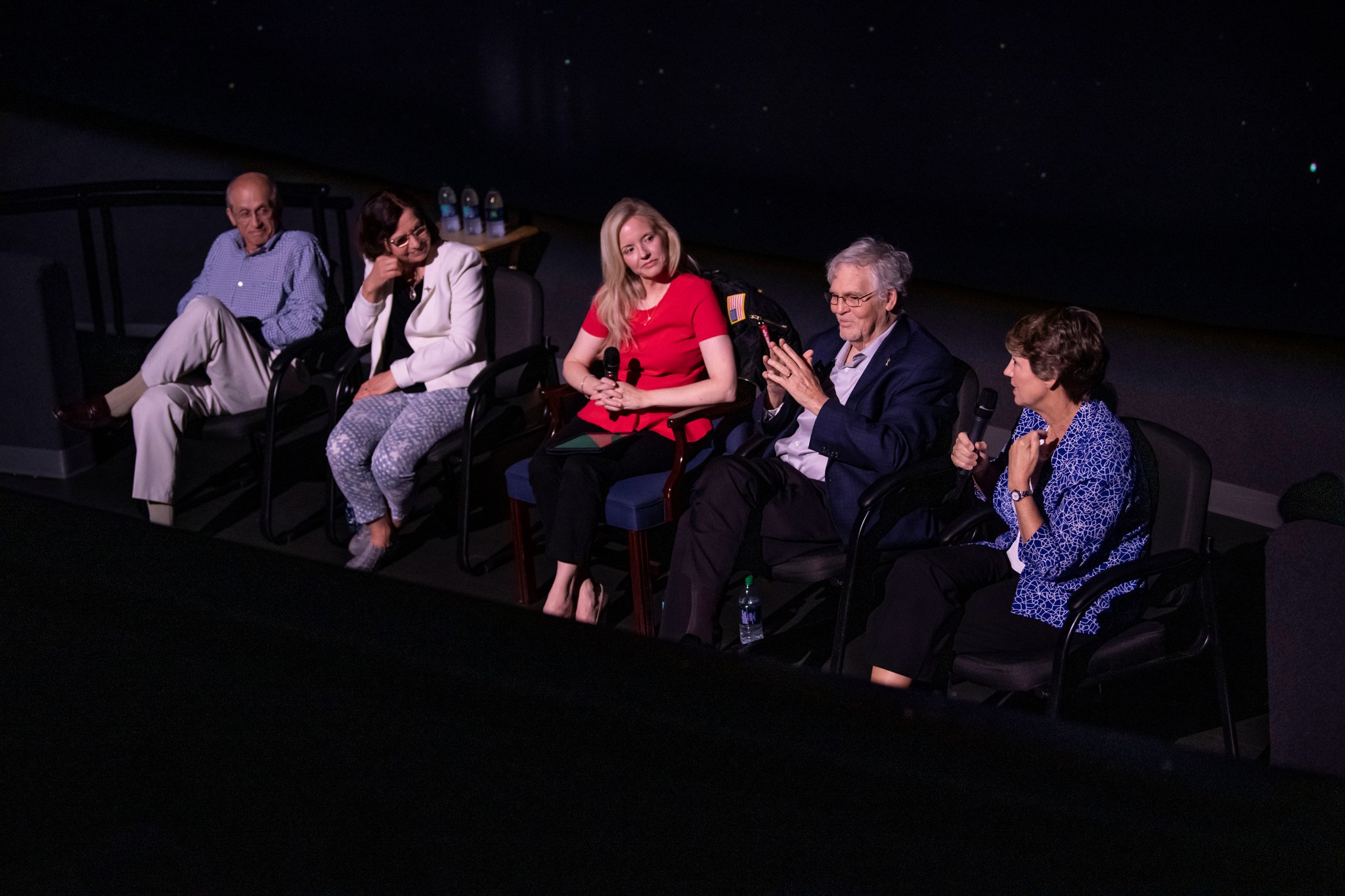
Retired NASA astronaut Eileen Collins, right, addresses the Chandra X-ray Observatory 20th anniversary panel Sept. 4 at the U.S. Space & Rocket Center’s Intuitive Planetarium. The panel also featured, from left, Chandra X-ray Center senior astrophysicist Harvey Tananbaum, Chandra X-ray Center astrophysicist Aneta Siemiginowska, Chandra X-ray Center visualization lead Kimberly Kowal Arcand and Chandra project scientist Martin Weisskopf of NASA’s Marshall Space Flight Center. (NASA/Fred Deaton)
Save the Date: Space Shuttle Columbia National Tour, Decision Management Course Coming to Marshall
By Will Bryan
Life can be a cruel teacher, often giving the test before it provides the lesson. For those at NASA and in the spaceflight industry, the test is hard, and the lessons sometimes come with great loss. While the loss is tremendous, the lessons are collected, shared and taught to help prevent the situation from ever happening again.
One such tool is the APPEL Knowledge Services’ Complex Decision Making in Project Management course. It will be taught at NASA’s Marshall Space Flight Center on Oct. 30-31 as part of The Space Shuttle Columbia National Tour. The goal of the two-day course is to provide multiple opportunities for participants to gain experience in complex decision making and critical thinking through group discussions and examination of lessons learned from relevant case studies.
On Nov. 5, The Space Shuttle Columbia National Tour exhibit will open in Marshall’s Building 4221 lobby, and a town hall in Building 4316 will kick off a week of activities to discuss technical authority and risk management. The exhibit displays pieces of Columbia recovered after the accident in 2003.
Using the lessons learned from the loss of Columbia, the discussions will help both Marshall’s veteran and early career engineers, leaders and workforce understand what happened in order to help prevent another accident from occurring. Panel discussions and lunch-and-learns will affirm to Marshall’s workforce the importance of listening to all concerns in the decision-making process.
The path to the Moon and Mars goes through Marshall, making it crucial that the team understands and is prepared to handle complex decisions where mission success and lives are on the line. Using the lessons learned from Columbia, as well as Challenger and Apollo 1, the week of discussions will help ensure that the missions undertaken now and in future stand the best possible chance of being successful.
More information about the week’s activities will be posted on ExplorNet as it becomes available.
Bryan, an ASRC Federal/Analytical Services employee, supports the Office of Strategic Analysis & Communications.
Progress to the Pad: The Hardware for NASA’s Artemis I Mission Comes Together
Over the course of their development, NASA’s powerful Space Launch System rocket and NASA’s Orion spacecraft have moved from design and manufacturing to testing and assembly to integration. Some of the hardware has even been delivered to the launch pad at NASA’s Kennedy Space Center. Along with the Gateway in lunar orbit and a new human landing system, SLS and Orion create the backbone for the agency’s Artemis missions to the Moon that will land astronauts on the lunar surface by 2024. From top to bottom, you can take a look at the completed flight hardware for SLS and Orion for the first flight, Artemis I, in this latest video. For more information about Artemis, visit here. (NASA)
RSIC Building to Close; Online Registration Deadline Nearing
The Redstone Scientific Information Center will close its physical location Sept. 30, and begin operating exclusively as an online entity Oct. 1.
Civil servants and contractors of NASA’s Marshall Space Flight Center have until Sept. 20 to become a registered RSIC user, which allows access to RSIC’s online subscriptions through spring 2020. Contact RSIC at 256-876-5195 to learn how to register.
Following the closing of the RSIC building, book requests from Marshall team members must be made through Mary Ellen Harris. Books checked out become the property of the Marshall library, not of the employee. The library team will announce updates on spaces that become available for housing large book collections.
Marshall to Host Community College Students Sept. 23-27, Team Members Invited to Attend Networking, Competitive Events
By Brice Russ
Forty community college students from across the nation will visit NASA’s Marshall Space Flight Center from Sept. 23-27 for a hands-on, career-focused educational workshop — and organizers hope Marshall team members will take part, helping to inspire the Artemis generation of engineers and explorers.
The NASA Community College Aerospace Scholars program, now in its eighth year at Marshall, challenges students — most from minority-serving institutions — to complete a five-week online course focusing on NASA’s missions, including science aboard the International Space Station and the exploration of Mars. Students are then chosen for the workshop based on their achievement in the online course.
The result, said Marshall education specialist Vicki Smith, is an authentic NASA experience for community college students pursuing undergraduate coursework in science, technology, engineering and mathematics — the STEM fields.
“The program encourages students to finish a two-year degree or transfer to a four-year university to pursue a NASA-related field,” she added. “By taking part in activities and presentations, touring Marshall and the U.S. Space & Rocket Center, and especially by mingling with NASA personnel, they may be inspired to pursue internships and even lifelong careers.”
Kevin Vincent, who attended NCAS in 2018 and is now an education and technical specialist in Marshall’s Office of Strategic Analysis & Communications, agreed that the program provides excellent opportunities for students to learn about STEM careers at NASA that they might not otherwise be aware of.
“It’s a really great way to introduce students to NASA and to space in general,” he said.
The 40 students come from 31 community colleges, including northern Alabama’s Calhoun Community College. During their stay, they’ll work in four teams mentored by Marshall engineers. Each team will design and build a prototype Martian rover — using Lego advanced robotics kits — and prepare a marketing package to formally present the design to NASA representatives at the close of the workshop. Participants will also take part in a pair of rover challenges, using their own creations to collect rock and mineral samples and rescue stranded Mars rovers.
The program will host a special networking lunch Sept. 26 from noon to 1 p.m. at the Building 4203 cafeteria. Marshall team members are encouraged to attend, to speak with students and answer questions about careers at NASA. Team members are also invited to attend the rover competitions, in the Science Lab at Marshall’s Education Training Facility at the U.S. Space & Rocket Center, from 9 to 10 a.m. on Sept. 25, and 2:30 to 3:30 p.m. on Sept. 26.
NCAS, which is administered by NASA’s Johnson Space Center and sponsored by the Minority University Research and Education Project, is organized by the STEM Engagement Office in Marshall’s Office of Strategic Analysis & Communications. The program was founded at Johnson in 2012. Today, NASA hosts scholars workshops at all 10 field centers. Applications for the next NCAS workshop will close Oct. 16.
Russ, an ASRC Federal/Analytical Services employee, supports the Office of Strategic Analysis & Communications.
Learn How Apollo F-1 Engines Were Recovered from Atlantic Ocean

David Concannon will share the story of how he and his team recovered Apollo F-1 engines from the Atlantic Ocean in 2013, during a lunch and learn Sept. 12 at 11 a.m. in Room 1201 of Building 4203 at NASA’s Marshall Space Flight Center. He will also speak at the U.S. Space & Rocket Center’s Discovery Theater at 2:30 p.m. as part of the Pass the Torch lecture series. There is no admission fee for the Pass the Torch event. Jeff Bezos, founder of Blue Origin and Amazon.com, asked Concannon to lead the Apollo F-1 Engine Search & Recovery Project. Over the course of three years and two expeditions, Concannon’s 100-member team found the remnants of eight Apollo missions, including Apollo 11. (David Concannon)
Astrobotic Mission Director to Deliver Tech Talk on Sept. 12
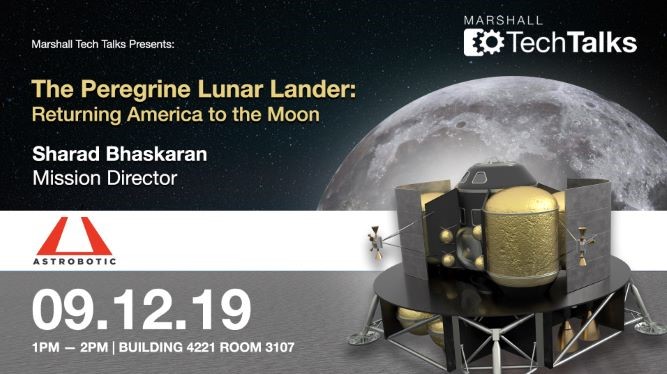
Sharad Bhaskaran, mission director for the firm Astrobotic in Pittsburgh, will present the monthly NASA Marshall Space Flight Center Tech Talk on Sept. 12 at 1 p.m. in Room 3107 of Building 4221. Astrobotic is one of the commercial companies developing a lunar lander as part of NASA’s Commercial Lunar Payload Services. Its lander, the Peregrine Lunar Lander, will possess unique technologies that Bhaskaran will discuss. Astrobotic has worked with NASA for the past three years through the Lunar CATALYST program. (NASA)
Former Johnson Director Ellen Ochoa Delivers Final 2019 Shared Experiences Talk at Marshall
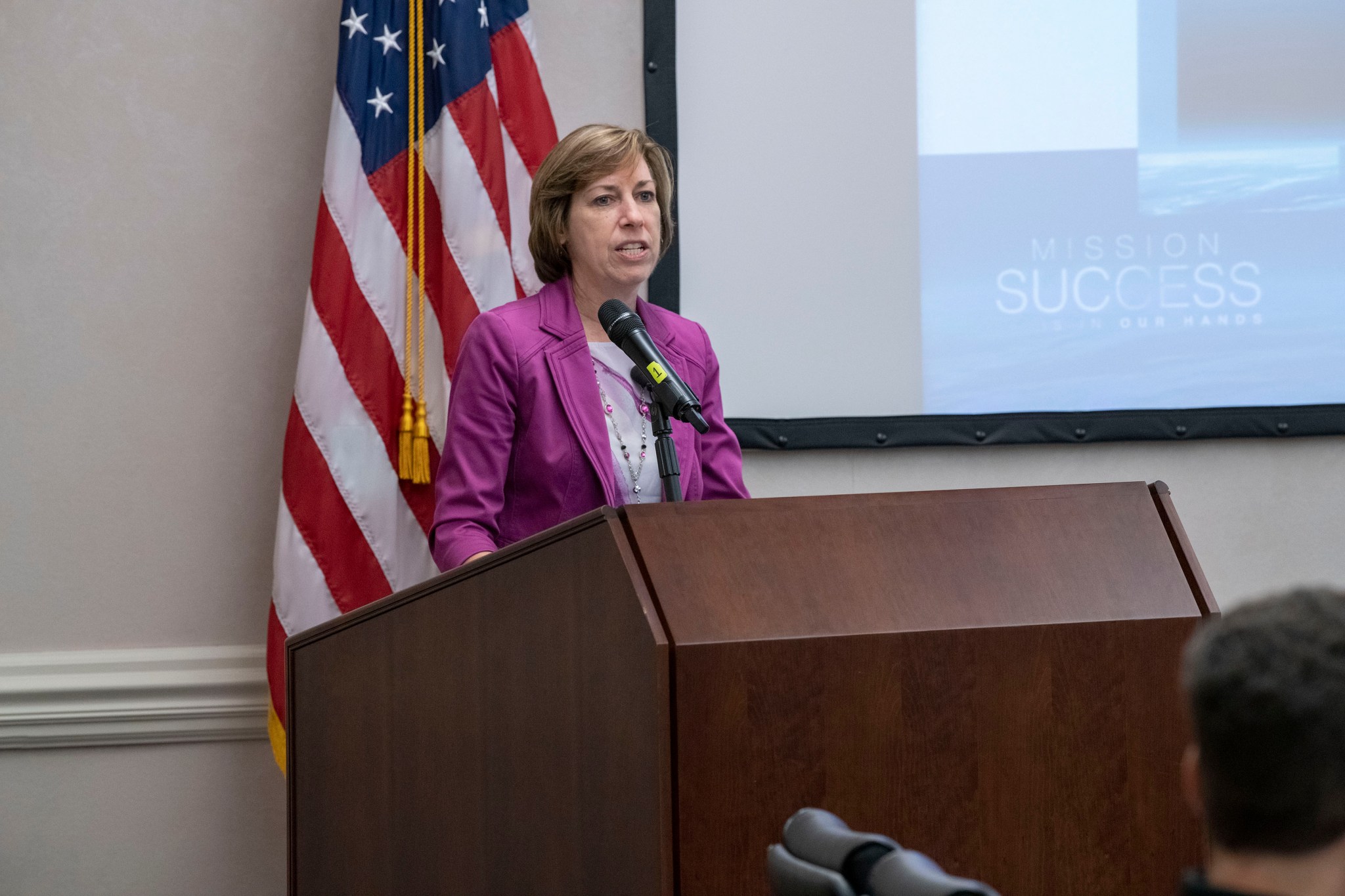
Ellen Ochoa, former director of NASA’s Johnson Space Center and retired space shuttle astronaut, speaks during the September Shared Experiences Forum, part of the “Mission Success is in Our Hands” lecture series, at NASA’s Marshall Space Flight Center on Sept. 5. Ochoa shared her experiences gained in various roles at NASA, including as the deputy director of Flight Crew Operations at Johnson. In that role, she was an important part in returning NASA to flight after the loss of space shuttle Columbia in 2003 and in assuring that each mission after Columbia was poised for the greatest chance of success. Through specific examples from her career, she conveyed the importance of fully understanding various issues and making informed, thoughtful decisions on how to best mitigate problems and risks. The lecture series — sponsored by Marshall’s Safety & Mission Assurance Directorate and industry partner Jacobs Engineering of Huntsville — is designed to strengthen Marshall’s focus on all aspects of crew, hardware and mission safety. The September lecture was the last of 2019; the series will return in 2020. (NASA/Fred Deaton)
This Week in NASA History: STS-106 Launches to International Space Station – Sept. 8, 2000
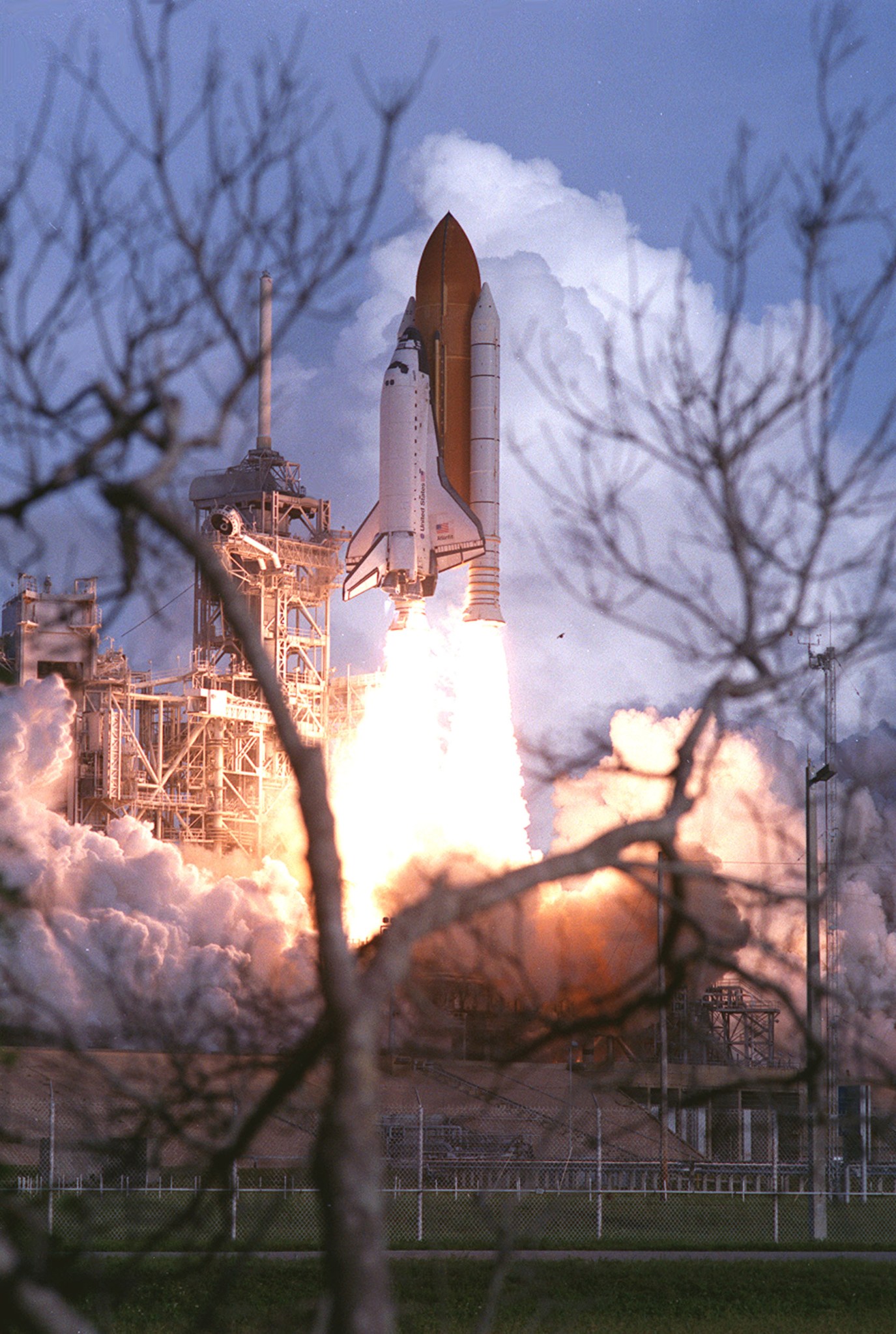
This week in 2000, space shuttle Atlantis, mission STS-106, lifted off from NASA’s Kennedy Space Center on an 11-day mission to the International Space Station. STS-106 completed all mission objectives to prepare the station for the first crew, scheduled for launch October 2000. The mission focused on unloading nearly 3 tons of cargo from the orbiter and Progress supply craft already docked to the opposite end of the station. The crew transferred more than 6,000 pounds of material, including food, water, office supplies, onboard environmental supplies and a computer and monitor to the interior of the station. Today, the Payload Operations Integration Center at NASA’s Marshall Space Flight Center serves as “science central” for the International Space Station, working 24/7, 365 days a year in support of the orbiting laboratory’s science experiments. The NASA History Program is responsible for generating, disseminating and preserving NASA’s remarkable history and providing a comprehensive understanding of the institutional, cultural, social, political, economic, technological and scientific aspects of NASA’s activities in aeronautics and space. For more pictures like this one and to connect to NASA’s history, visit the Marshall History Program’s webpage. (NASA)





























